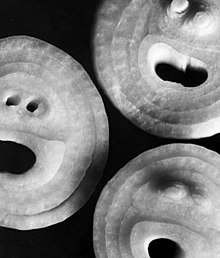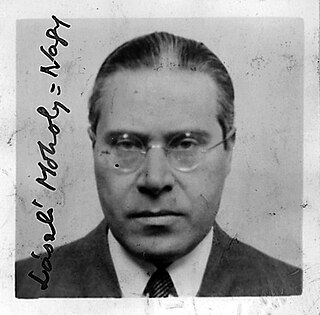
László Moholy-Nagy was a Hungarian painter and photographer as well as a professor in the Bauhaus school. He was highly influenced by constructivism and a strong advocate of the integration of technology and industry into the arts. The art critic Peter Schjeldahl called him "relentlessly experimental" because of his pioneering work in painting, drawing, photography, collage, sculpture, film, theater, and writing.
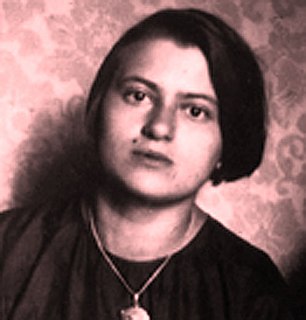
Marianne Brandt was a German painter, sculptor, photographer, metalsmith, and designer who studied at the Bauhaus art school in Weimar and later became head of the Bauhaus Metall-Werkstatt in Dessau in 1927. Today, Brandt's designs for household objects such as lamps and ashtrays are considered timeless examples of modern industrial design. She also created photomontages.
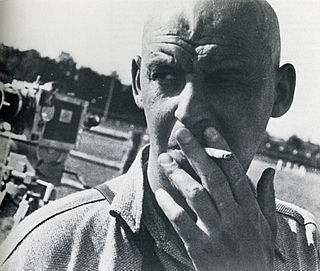
Aleksander Mikhailovich Rodchenko was a Russian and Soviet artist, sculptor, photographer, and graphic designer. He was one of the founders of constructivism and Russian design; he was married to the artist Varvara Stepanova.
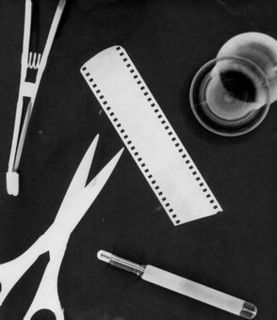
A photogram is a photographic image made without a camera by placing objects directly onto the surface of a light-sensitive material such as photographic paper and then exposing it to light.

Constructivism is an early twentieth-century art movement founded in 1915 by Vladimir Tatlin and Alexander Rodchenko. Abstract and austere, constructivist art aimed to reflect modern industrial society and urban space. The movement rejected decorative stylization in favor of the industrial assemblage of materials. Constructivists were in favour of art for propaganda and social purposes, and were associated with Soviet socialism, the Bolsheviks and the Russian avant-garde.
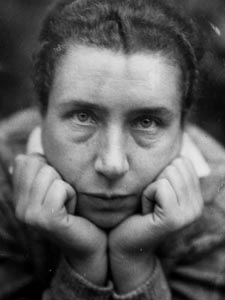
Lucia Moholy was a photographer and publications editor. Her photos documented the architecture and products of the Bauhaus, and introduced their ideas to a post-World War II audience. However Moholy was seldom credited for her work, which was often attributed to her husband László Moholy-Nagy or to Walter Gropius.

Iwao Yamawaki, born Iwao Fujita, was a Japanese photographer and architect who trained at the Bauhaus.
A luminogram is an image, usually made with an artistic purpose, created by exposure of photosensitive materials to light without the intervention of an object,
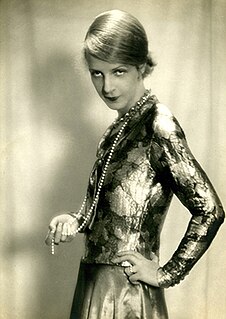
Sibyl Moholy-Nagy was an architectural and art historian. Originally a German citizen, she accompanied her second husband, the Hungarian Bauhaus artist László Moholy-Nagy, in his move to the United States. She was the author of a study of his work, Moholy-Nagy: Experiment in Totality, plus several other books on architectural history.

Modern typography was a reaction against the perceived decadence of typography and design of the late 19th century. It is mostly associated with the works of Jan Tschichold and Bauhaus typographers Herbert Bayer, László Moholy-Nagy, El Lissitzky and others.

Florence Henri was a surrealist artist; primarily focusing her practice on photography and painting, in addition to pianist composition. In her childhood, she traveled throughout Europe, spending portions of her youth in Paris, Vienna, and the Isle of Wight. She studied in Rome, where she would encounter the Futurists, finding inspiration in their movement. From 1910 to 1922, she studied piano in Berlin, under the instruction of Egon Petri and Ferrucio Busoni. She would find herself landlocked to Berlin during the first World War, supporting herself by composing piano tracks for silent films. She returned to Paris in 1922, to attend the Académie André Lhote, and would attend until the end of 1923. From 1924 to 1925, she would study under painters Fernand Léger and Amédée Ozenfant at the Académie Moderne. Henri's most important artistic training would come from the Bauhaus in Dessau, in 1927, where she studied with masters Josef Albers and László Moholy-Nagy, who would introduce her to the medium of photography. She returned to Paris in 1929 where she started seriously experimenting and working with photography up until 1963. Finally, she would move to Compiègne, where she concentrated her energies on painting until the end of her life in 1982. Her work includes experimental photography, advertising, and portraits, many of which featured other artists of the time.

Gertrud Arndt was a German photographer and designer associated with the Bauhaus movement. She is remembered for her pioneering series of self-portraits from around 1930.
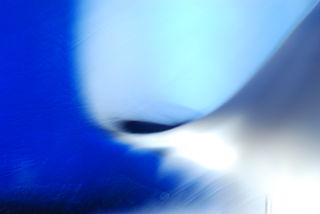
Abstract photography, sometimes called non-objective, experimental or conceptual photography, is a means of depicting a visual image that does not have an immediate association with the object world and that has been created through the use of photographic equipment, processes or materials. An abstract photograph may isolate a fragment of a natural scene in order to remove its inherent context from the viewer, it may be purposely staged to create a seemingly unreal appearance from real objects, or it may involve the use of color, light, shadow, texture, shape and/or form to convey a feeling, sensation or impression. The image may be produced using traditional photographic equipment like a camera, darkroom or computer, or it may be created without using a camera by directly manipulating film, paper or other photographic media, including digital presentations.
Ivana Tomljenović-Meller, born Ivana Tomljenović, was a graphic designer and art teacher from Zagreb who attended the Bauhaus art school in Germany.
Judit Kárász was a Hungarian photographer interested in the medium's ability to reveal the hidden structures of everyday subject matter. Her photography brought together social documentary and modernist ideas such as Gestalt theory.

The Bauhaus was seen as a progressive academic institution, as it declared equality between the sexes and accepted both male and female students into its programs. During a time when women were denied admittance to formal art academies, the Bauhaus provided them with an unprecedented level of opportunity for both education and artistic development, though generally only in weaving and other fields considered at the time to be appropriate for women.
Alice Lex-Nerlinger was a German mid-20th century artist in the media of painting, photography, photomontage and photograms.
Carola Giedion-Welcker was a German-Swiss art historian.
Arthur Sidney Siegel was an American photographer and educator.
Annelise Kretschmer (1903-1987) was a German portrait photographer.
